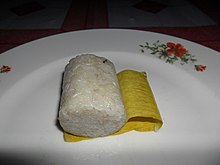Lemang
 Lemang being cooked in hollow bamboo pieces | |
| Region or state | Brunei, Indonesia, Malaysia, Singapore |
|---|---|
| Main ingredients | Glutinous rice, coconut milk |
Lemang is a traditional food made of glutinous rice, coconut milk and salt, cooked in a hollowed bamboo stick lined with banana leaves in order to prevent the rice from sticking to the bamboo. It is commonly found in maritime Southeast Asian countries, especially Brunei, Indonesia, Malaysia and Singapore.
The bamboo tube containing glutinous rice, salt and coconut milk is placed slightly slanted on a small fire with the opening facing upwards and should be turned regularly in order to make it evenly cooked. It takes about 4–5 hours to cook lemang.
Lemang is commonly eaten to mark the end of daily fasting during the annual Muslim holidays of Eid-ul-Fitr and Eid-ul-Adha,[1] Lemang is popular in countries such as Brunei, and originated from Malaysia and Indonesia.[2]
The cooking method using a bamboo container is common among several ethnicities including Malays, Minang, Minahasa, Dayak as well as Orang Asli tribes.[3][4][5]
Iban people usually prepar lemang for celebrations such as the harvest festival of Hari Gawai, lemang is usually eaten with meat dishes such as chicken curry. The cooking process used in making lemang for many different meats, also known as "pansoh/pansuh" by indigenous Dayak communities.[6]
-
Cutting the hollowed bamboo to retrieve the lemang inside
-
A piece of Lemang
References
- ^ Cecil Lee (September 22, 2009), "Travel Snapshot – Celebrate Hari Raya Aidilfitri With Lemang", Travel Feeder
- ^ Bahrum Ali; Bandar Seri Begwan (September 8, 2009), "'Lemang' stalls are found everywhere", The Brunei Times
- ^ Ivor Hugh Norman Evans (1968), The Negritos of Malaya, p. 59, ISBN 9780714620060
- ^ Geoffrey Benjamin; Cynthia Chou (2002), Tribal Communities in the Malay World: Historical, Cultural, and Social Perspectives, Institute of Southeast Asian Studies, p. 149, ISBN 9789812301666
- ^ An encyclopædia of gardening: comprising the theory and practice ..., Volume 1 By John Claudius Loudon, Mrs. Loudon (Jane)
- ^ "'Ayam pansuh' — A Sarawak exotic delicacy loved by many", Malay Mail Online, June 28, 2015, retrieved July 14, 2016


